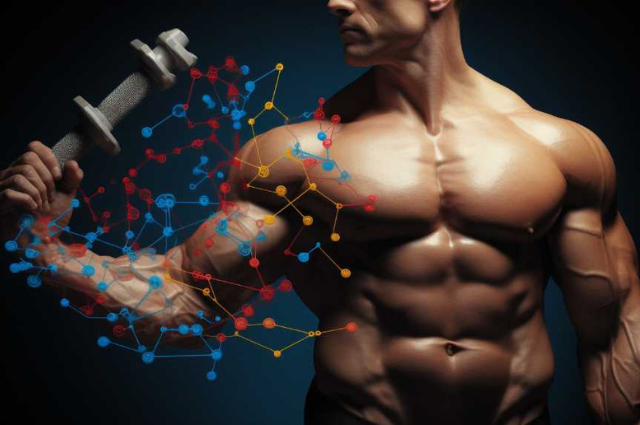Steroids Showdown: Anabolic Vs Corticosteroids Explained

In the extensive world of steroids, the two main types often discussed are anabolic and corticosteroids. Both serve distinct purposes within the medical field and have different profiles of effects and side effects.
The forthcoming discussion titled 'Steroids Showdown: Anabolic vs Corticosteroids Explained' will provide a comprehensive examination of these two classes of steroids. We will delve into their definitions, uses, and potential risks to elucidate their distinct characteristics.
The aim is to equip the reader with a clear understanding of their differences and similarities, shedding light on their unique roles in medical practice.
Key Takeaways
- Steroids are organic compounds that serve as essential components of cell membranes and act as signaling molecules for biological functions.
- Corticosteroids are produced in the adrenal cortex and are used medically for various conditions, such as immune response, stress response, metabolism, and inflammation regulation.
- Anabolic steroids are synthetic substances related to male sex hormones and are often misused by athletes and bodybuilders for muscle-building and performance-enhancing effects.
- Misuse of anabolic steroids can have serious physical and psychological health risks, including liver damage, cardiovascular issues, hormonal imbalances, and addiction. Meanwhile, corticosteroids are commonly prescribed for autoimmune diseases, asthma, allergies, and skin conditions, but long-term usage can lead to serious side effects and increased susceptibility to infections.
Understanding Steroids Basics
Before delving into the differences between anabolic and corticosteroids, it is crucial to first understand the foundational basics of steroids and their role in the body. Steroids are organic compounds that naturally occur in the body. They serve as essential components of cell membranes and also act as signaling molecules for biological functions.
Steroids encompass a variety of substances, including sex hormones, cholesterol, vitamin D, and other compounds. They are generally categorized into two main classes: corticosteroids and anabolic steroids. Despite their shared classification, these two groups of steroids serve distinct purposes within the body and operate through different mechanisms.
Corticosteroids, also known as glucocorticoids, are a type of steroid hormone produced in the adrenal cortex. They play a significant role in a range of physiological processes, including immune response, stress response, metabolism, and regulation of inflammation. Prednisone, hydrocortisone, and dexamethasone are common examples of corticosteroids.
On the other hand, anabolic steroids are synthetic substances related to male sex hormones, known as androgens. They are primarily used medically to stimulate bone growth, appetite, and to induce male puberty. In addition, they are used to treat chronic diseases such as cancer and AIDS, which cause muscle loss. However, they are often misused by athletes and bodybuilders for their muscle-building properties.
Understanding these fundamental aspects of steroids is pivotal to appreciating their broader implications in medicine, sports, and society at large. With this foundation, we can proceed to discuss the differences between anabolic and corticosteroids.

Anabolic Steroids Defined
Anabolic steroids, a class of synthetic compounds, mirror the effects of naturally occurring testosterone in the body, facilitating increased protein synthesis within cells and leading to an enhanced growth of muscle tissue. These substances are often misused in the sporting world for their muscle-building and performance-enhancing effects.
Anabolic steroids have a wide range of medical uses, but their misuse can lead to serious health complications. To better understand this, let's examine the following:
- Uses of Anabolic Steroids
- Medical Uses: They are used in medicine to treat conditions like delayed puberty, impotence, and muscle loss from certain diseases.
- Athletic Uses: Athletes often misuse these substances to increase muscle mass and improve performance, despite the associated risks.
- Non-medical, Non-athletic Uses: Some people use anabolic steroids for cosmetic reasons, to achieve a muscular physique.
The misuse of anabolic steroids can result in a multitude of health issues, both physical and psychological. It's crucial to understand the implications of their use and misuse:
- Implications of Anabolic Steroids Use & Misuse
- Physical Health Risks: These include liver damage, heart disease, and fertility issues, among others.
- Psychological Health Risks: Misuse can lead to mood swings, aggression, and other psychological effects.
- Legal Implications: In many jurisdictions, the non-medical use of anabolic steroids is illegal.
Uses of Anabolic Steroids
In the realm of medical treatment, anabolic steroids serve a critical role in addressing conditions such as delayed puberty, impotence, and muscle loss from certain diseases. These synthetic variants of the male sex hormone testosterone are particularly effective in promoting the growth of skeletal muscle and developing secondary male sexual characteristics.
Beyond their therapeutic use, anabolic steroids are also utilized significantly in the sports and bodybuilding industries to enhance performance and improve physical appearance. Athletes often use these drugs to increase muscle mass, strength, and endurance. However, the non-medical use of anabolic steroids is controversial due to the potential for abuse and harmful side effects, including liver damage, cardiovascular disease, and behavioral changes.
In the medical field, the use of anabolic steroids is carefully monitored and prescribed under specific conditions. For instance, they are used in the treatment of hypogonadism, a condition where the body produces insufficient testosterone. In such cases, anabolic steroids can help restore hormonal balance and mitigate symptoms like low libido, depression, and fatigue.
Moreover, anabolic steroids are also used in the treatment of cachexia, a wasting syndrome that causes significant muscle and weight loss, often associated with chronic diseases like cancer, HIV/AIDS, and heart failure. By promoting muscle growth and weight gain, these steroids can improve the patient's quality of life and increase their ability to tolerate intensive treatments.
Anabolic Steroids Side Effects
Despite their therapeutic benefits, the misuse of anabolic steroids can lead to a multitude of harmful side effects. These side effects can be broadly categorized into physical, psychological, and hormonal effects.
- Physical Effects
- Cardiovascular issues: Prolonged use of anabolic steroids could result in the development of cardiovascular diseases, which include heart attacks and strokes. It can lead to alterations in cholesterol levels and cause blood clots.
- Liver damage: Anabolic steroids have been associated with liver tumors and a condition called peliosis hepatis, in which blood-filled cysts form in the liver.
- Skin conditions: Steroid misuse can lead to acne, cysts, and oily hair and skin.
- Psychological Effects
- Mood swings: Users may experience significant mood swings, ranging from manic symptoms to bouts of depression or even suicidal thoughts.
- Aggression: Known colloquially as 'roid rage,' some users may experience heightened irritability and aggression.
- Addiction: Anabolic steroids can lead to psychological dependence, resulting in withdrawal symptoms when usage is stopped.
- Hormonal Effects
- Men: Men may experience testicular atrophy, reduced sperm count, infertility, baldness, development of breasts, and an increased risk for prostate cancer.
- Women: Women might experience menstrual irregularities, reduced breast size, a deepened voice, increased body hair, and baldness.
Corticosteroids: A Comprehensive Look
Shifting focus to corticosteroids, these are a class of drugs designed to mimic the effects of hormones produced by the adrenal glands, and are primarily used to reduce inflammation and suppress the immune system in a variety of medical conditions. This class of steroids is frequently used in the treatment of autoimmune diseases such as lupus and rheumatoid arthritis, as well as in asthma, allergies, and certain skin conditions.

Corticosteroids work by slowing down the immune system's response, thereby reducing inflammation and pain. They can be administered in various forms such as tablets, inhalers, injections, or topical creams and ointments. The type of corticosteroid and the method of administration are usually determined by the specific condition being treated.
However, while corticosteroids are powerful and effective medications, their use is not without risks. Long-term usage can lead to serious side effects, including osteoporosis, high blood pressure, diabetes, and suppressed adrenal gland hormone production. Additionally, because corticosteroids suppress the immune system, they can increase susceptibility to infections.
It is vital for healthcare providers to weigh the benefits against the potential risks when prescribing corticosteroids. Strict adherence to dosage instructions and regular monitoring are crucial to mitigate the risks associated with the long-term use of these drugs.
Medical Applications of Corticosteroids
Numerous medical conditions, ranging from autoimmune diseases to allergies, utilize the potent anti-inflammatory and immune-modulating properties of corticosteroids for treatment. Corticosteroids, due to their broad spectrum of action, play a crucial role in the management and control of numerous medical conditions, paving the way for more targeted therapies.
The medical applications of corticosteroids are as diverse as the conditions they treat, which can be categorized into three broad areas:
- Autoimmune Diseases: Corticosteroids are a mainstay in the management of autoimmunity. They suppress the overactive immune response, thereby alleviating symptoms and preventing tissue damage.
- Rheumatoid Arthritis: Corticosteroids help control inflammation and pain, and slow down joint damage.
- Lupus: They are used to manage flares and prevent organ damage.
- Multiple Sclerosis: For acute relapses, high-dose corticosteroids can speed up recovery.
- Allergic Conditions: Corticosteroids are effective in controlling allergic reactions by inhibiting specific cells and chemicals in the immune system.
- Asthma: Inhaled corticosteroids control and prevent asthma symptoms.
- Allergic Rhinitis: Nasal corticosteroids are a common treatment for inflammation in the nose.
- Eczema: Topical corticosteroids can reduce inflammation and alleviate symptoms.
- Other Conditions: Aside from these, corticosteroids have other significant applications.
- Addisons Disease: Patients with this condition require lifelong corticosteroid replacement therapy.
- Septic Shock: In severe cases, corticosteroids can be life-saving.
Despite their benefits, corticosteroids need to be used judiciously due to potential side effects, emphasizing the importance of regular monitoring and dose adjustment to optimize therapeutic outcomes.
Potential Risks of Corticosteroids
In the realm of healthcare, it is crucial to understand that while corticosteroids possess potent therapeutic properties, they also come with potential risks and side effects that necessitate careful usage and monitoring. The potential risks of corticosteroids are wide-ranging, with the intensity and likelihood of these risks often correlating with the dosage, duration of treatment, and the individual patient's health status.
One of the most common side effects of corticosteroids is an increased susceptibility to infections due to the immunosuppressive properties of these drugs. This means that patients taking corticosteroids may have a diminished ability to fight off infections, leading to an increased risk of developing serious conditions such as pneumonia or sepsis.
Corticosteroids can also lead to a variety of metabolic effects, including hyperglycemia, hypertension, and dyslipidemia. This can be particularly problematic for individuals with underlying conditions such as diabetes or heart disease. Furthermore, long-term use of corticosteroids can lead to osteoporosis and fracture risk due to decreased bone density, as well as adrenal insufficiency, a condition where the body cannot produce enough of its own steroids.

Psychological effects are another potential risk, with corticosteroids linked to mood swings, memory issues, and even psychosis in severe cases. Eye problems such as glaucoma and cataracts have also been associated with corticosteroid use.
Anabolic Vs Corticosteroids: The Showdown
Comparing the two major types of steroids, anabolic and corticosteroids, a significant distinction in their purposes, usage, and side effects becomes evident. Anabolic steroids are primarily used to stimulate muscle growth and improve physical performance, often misused by athletes for doping purposes. Corticosteroids, on the other hand, are prescribed by doctors to reduce inflammation and suppress the immune system in conditions like asthma, rheumatoid arthritis, and lupus.
To further understand the differences, consider the following points:
- Purposes:
- Anabolic Steroids: Enhance physical performance, stimulate muscle growth, and treat hormone problems.
- Corticosteroids: Reduce inflammation, control overactive immune responses, and treat autoimmune diseases.
- Usage:
- Anabolic Steroids: Often misused in sports for doping, taken orally, or injected.
- Corticosteroids: Prescribed by doctors, taken orally, topically, or injected, depending on the condition.
- Side Effects:
- Anabolic Steroids: Can lead to hormonal imbalances, liver damage, cardiovascular diseases, and psychiatric disorders.
- Corticosteroids: May cause weight gain, osteoporosis, mood changes, and increased risk of infections.
The distinction between anabolic and corticosteroids is not just in their names but also in their functions, usage, and the risks involved. It's essential to understand these differences to make informed decisions about their use. Misuse of either can have severe health implications. While anabolic steroids may provide quick gains in physical performance, their prolonged use can lead to serious health issues. Similarly, corticosteroids, though beneficial in managing inflammation, need to be used with caution due to potential side effects.
Frequently Asked Questions
What Is the Legal Status of Anabolic and Corticosteroids in Different Countries?
The legality of anabolic and corticosteroids varies worldwide. Anabolic steroids, often associated with performance enhancement, are considered controlled substances in many countries, including the US, Canada, and the UK. Misuse is punishable by law.
Corticosteroids, used primarily for medicinal purposes, are generally legal and available with a prescription. However, regulations may differ, so it's essential to verify local laws to understand the legal landscape surrounding these substances.
Can These Steroids Interact With Other Medications or Substances, and if So, How?
Yes, both anabolic and corticosteroids can interact with other medications or substances.
Anabolic steroids can interfere with insulin, blood thinners, and substances that affect liver enzymes, potentially causing harmful effects.
Corticosteroids can interact with medicines like aspirin, diuretics, and immunosuppressants, which can increase the risk of side effects.

These interactions underscore the importance of medical supervision when taking steroids.
Are There Natural Alternatives or Supplements That Can Achieve Similar Results as Anabolic or Corticosteroids?
Yes, there are natural alternatives that can mimic the effects of anabolic or corticosteroids. For anabolic effects, resistance training and protein-rich diets can enhance muscle growth.
Omega-3 fatty acids can provide anti-inflammatory benefits similar to corticosteroids. However, the efficacy of these alternatives can vary widely among individuals.
It is recommended to consult a healthcare provider before starting any new supplement or exercise regimen.
How Does the Prolonged Usage of These Steroids Affect Mental Health?
Prolonged use of both anabolic and corticosteroids can have significant mental health effects.
Anabolic steroids, often abused for muscle gain, can lead to mood swings, irritability, aggression, and even psychotic symptoms.
Corticosteroids, used for inflammation and autoimmune conditions, may cause anxiety, depression, and problems with memory and concentration.
It's crucial to monitor mental health when using these substances for extended periods.
How Does the Body's Natural Steroid Production Get Affected by the Prolonged Use of Anabolic and Corticosteroids?
Prolonged use of anabolic and corticosteroids can suppress the body's natural steroid production.

Anabolic steroids can cause a decline in the body's natural testosterone levels, resulting in hormonal imbalances.
Corticosteroids, on the other hand, can suppress the adrenal glands' production of cortisol, a natural steroid hormone.
Over time, this can lead to adrenal insufficiency, a condition where the adrenal glands cannot produce sufficient amounts of cortisol.
Conclusion
In conclusion, both anabolic steroids and corticosteroids play significant roles in the medical field.
Anabolic steroids, primarily used for muscle growth and performance enhancement, carry substantial risks.
On the other hand, corticosteroids are used for inflammation and immune system regulation. They also present potential side effects.
Therefore, while both have their unique benefits, they also pose potential health risks, underlining the importance of their judicious and medically-supervised use.
